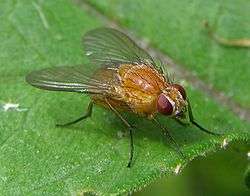Phaonia pallida
Phaonia pallida, the muscid fly or orange muscid fly, is a species of fly in the family Muscidae.[1]
| Phaonia pallida | |
|---|---|
 | |
| Phaonia pallida. Female | |
| Scientific classification | |
| Kingdom: | |
| Phylum: | |
| Class: | |
| Order: | |
| Family: | |
| Genus: | |
| Species: | P. pallida |
| Binomial name | |
| Phaonia pallida (Fabricius, 1787) | |
| Synonyms | |
| |
Distribution and habitat
This species is distributed across parts the Palaearctic ecozone (Europe: (incl. Sicily), Russia: Asia: Israel, Turkey, Iran; Azores).[2][3] These flies mainly inhabit deciduous forests and woodland, especially spruce forest edge.[4][5]
Description
Phaonia pallida can reach a length of about 5.5–7.9 millimetres (0.22–0.31 in). These flies have an orange body with a very hairy thorax.[4][5] The antennae are composed by three articles and bear a feathery arista. The legs and the balancers are yellow, while the tarsi are black. The eyes are dark red, separated by a yellow marking in the females, while in males they are very close to each other.[6]
Biology
Adults fly from May to September, feeding on nectar of flowers (especially of Heracleum sphondylium).[4][5][6] Its larvae have been found growing in various fungi (Amanita rubescens, Clitocybe nebularis, Paralepista flaccida, Xerula radicata, Hymenopellis radicata, Amanita muscaria) [6] but also in rotten wood and under tree bark.[5][7] The last larval instar of Phaonia pallida is carnivorous, feeding on small insects.[5][8]
Bibliography
- Chandler, Peter J. (2010). A Dipterist's Handbook (2nd Edition). The Amateur Entomologist. 15. Orpington, Kent, England: Amateur Entomologists' Society. pp. 525pp
- D'Assis Fonseca, E.C.M (1968). Diptera Cyclorrhapha Calyptrata: Muscidae. Handbooks for the Identification of British Insects. 10. London.: Royal Entomological Society of London. pp. 118pp.
- Gregor, F.; Rozkosny, R.; Bartak, M.; Vanhara, J. (2002). The Muscidae (Diptera) of Central Europe. Scientiarum Naturalium Universitatis Masarykianae Brunensis. 107. Masaryk.: Masaryk University. pp. 280pp.
References
| Wikispecies has information related to Phaonia pallida |
| Wikimedia Commons has media related to Phaonia pallida. |
- BioLib
- Catalogue of life
- Fauna europaea
- Nature Spot
- J.K. Lindsey Commanster
- Un monde dans mon jardin
- Chandler, Peter J. (2010). A Dipterist's Handbook (2nd Edition). The Amateur Entomologist. 15. Orpington, Kent, England: Amateur Entomologists' Society. pp. 525pp.
- Jan Sevck Diptera (excluding Mycetophilidae S. str.) associated with fungi in Czech and Slovak Republics: a survey of rearing records from 1998-2000